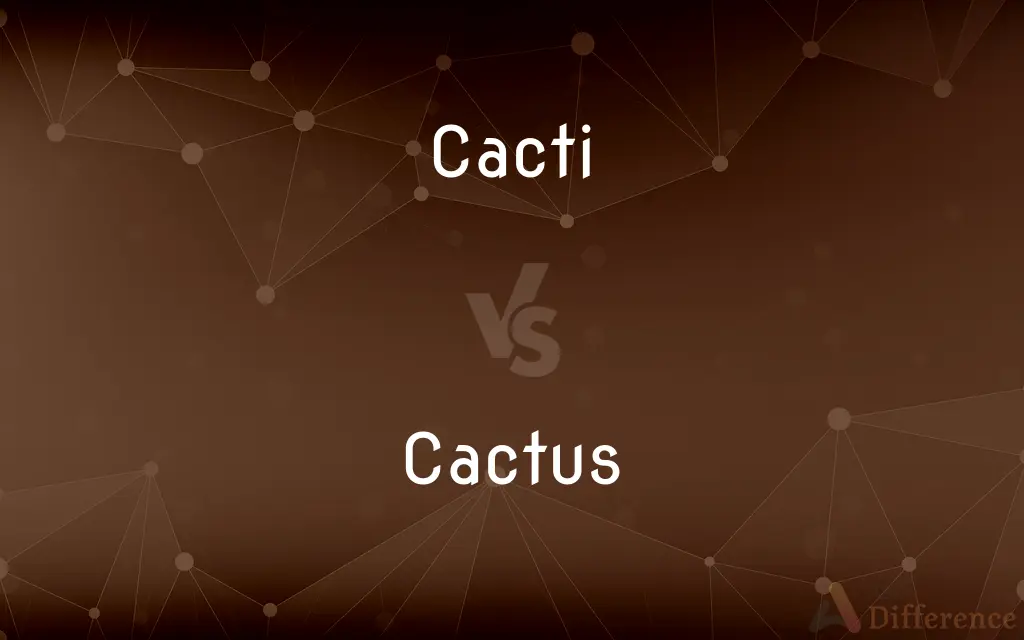Cacti vs. Cactus — What's the Difference?
By Tayyaba Rehman & Fiza Rafique — Updated on March 29, 2024
Cacti is the plural form, denoting multiple such plants, whereas cactus refers to a single plant known for its spiky surface and drought resistance.

Difference Between Cacti and Cactus
Table of Contents
ADVERTISEMENT
Key Differences
A cactus is a unique, resilient plant adapted to arid, desert environments, characterized by its thick, fleshy parts that store water, and are often covered with spines. On the other hand, cacti refer to more than one of these plants, emphasizing the diversity within this plant family, which includes a variety of shapes, sizes, and survival strategies.
While a single cactus can be an isolated study of adaptation, survival, and beauty in harsh conditions, cacti, as a group, represent the vast adaptability and ecological importance of these plants in their native habitats. This plural form allows discussions around biodiversity, ecosystem roles, and the evolutionary paths that have led to the wide range of species observed today.
The care for a cactus involves understanding the specific needs of that particular species, including sunlight, water, and temperature requirements. Conversely, caring for cacti involves a broader understanding of the different needs within this group, recognizing that what benefits one cactus might not be suitable for another, highlighting the importance of species-specific knowledge.
In literature and culture, a cactus might symbolize isolation or the ability to stand alone and thrive in difficult circumstances. However, cacti, with their diversity and collective presence, can symbolize community, resilience, and the beauty of diversity within adversity.
The conservation of a single cactus species can be critical, especially if it's endangered, focusing on specific threats and preservation strategies. In contrast, conservation efforts for cacti address broader issues, such as habitat loss, climate change, and the illegal trade of these plants, showcasing the need for comprehensive environmental policies.
ADVERTISEMENT
Comparison Chart
Definition
The plural form of cactus, referring to multiple such plants.
A single plant belonging to the family Cactaceae.
Significance
Highlights diversity and ecological roles within ecosystems.
Represents individual survival and adaptation.
Care Requirements
Requires knowledge of various species' differing needs.
Specific to the individual plant's species.
Symbolic Meaning
Symbolizes community, diversity, and collective resilience.
Often symbolizes resilience and the ability to thrive alone.
Conservation Focus
Addresses broader ecological and environmental concerns.
Concentrates on the survival of specific species.
Compare with Definitions
Cacti
Important for biodiversity and ecosystems in arid regions.
Cacti play a key role in providing food and shelter in the desert.
Cactus
Adapted to dry environments, often having spines instead of leaves.
The barrel cactus is easily recognized by its round shape and spines.
Cacti
Plural of cactus, referring to more than one such plant.
The greenhouse was filled with various cacti from around the world.
Cactus
Can bloom with flowers under the right conditions.
In spring, the cactus surprised everyone with its vibrant flowers.
Cacti
Represent a wide range of shapes, sizes, and colors.
The garden's collection of cacti included species from tiny to towering.
Cactus
A member of the plant family Cactaceae, known for its ability to store water.
The saguaro cactus stands tall in the desert landscape.
Cacti
Subject of study for their adaptations to extreme conditions.
Scientists study cacti to understand survival strategies in drought.
Cactus
A symbol of desert life and resilience.
The lone cactus became a symbol of survival in the vast desert.
Cacti
Often collected by enthusiasts for their diverse appearances.
His fascination with cacti led to a large and varied collection.
Cactus
Used in landscaping and as houseplants for their unique beauty.
She decorated her balcony with a small cactus collection.
Cacti
Any of numerous succulent, spiny, usually leafless plants of the family Cactaceae, native chiefly to arid regions of the Americas, having variously colored, often showy flowers with numerous stamens and petals.
Cactus
A cactus (plural cacti, cactuses, or less commonly, cactus) is a member of the plant family Cactaceae, a family comprising about 127 genera with some 1750 known species of the order Caryophyllales. The word "cactus" derives, through Latin, from the Ancient Greek κάκτος, kaktos, a name originally used by Theophrastus for a spiny plant whose identity is now not certain.
Cacti
Any of several similar plants.
Cactus
Any of numerous succulent, spiny, usually leafless plants of the family Cactaceae, native chiefly to arid regions of the Americas, having variously colored, often showy flowers with numerous stamens and petals.
Cactus
Any of several similar plants.
Cactus
(botany) Any member of the family Cactaceae, a family of flowering New World succulent plants suited to a hot, semi-desert climate.
Cactus
Any succulent plant with a thick fleshy stem bearing spines but no leaves, such as euphorbs.
Cactus
Non-functional, broken, exhausted, dead.
Cactus
Any plant of the order Cactacæ, as the prickly pear and the night-blooming cereus. See Cereus. They usually have leafless stems and branches, often beset with clustered thorns, and are mostly natives of the warmer parts of America.
Cactus
Any spiny succulent plant of the family Cactaceae native chiefly to arid regions of the New World
Common Curiosities
Why are cacti important to desert ecosystems?
They provide critical habitat, food sources for wildlife, and contribute to the ecosystem's balance.
Can all cacti survive in any desert?
While cacti are adapted to dry conditions, different species have specific needs and may not thrive in all deserts.
How often should a cactus be watered?
It varies by species and environment, but generally infrequently, allowing the soil to dry completely between waterings.
What makes a cactus unique among plants?
Its ability to store water, spiny surface, and adaptations to thrive in arid conditions make it unique.
Are all cacti covered in spines?
Most are, but some have fewer or no spines, depending on the species.
Can cacti grow in non-desert environments?
Yes, many cacti can adapt to various environments if their basic light and water needs are met.
How do cacti reproduce?
Cacti can reproduce through seeds from flowers or vegetatively through offsets or cuttings.
What are the main threats to cacti in the wild?
Habitat loss, illegal collection, and climate change are significant threats to cacti.
What's the difference between succulents and cacti?
All cacti are succulents, but not all succulents are cacti; cacti are distinguished by their areoles.
How do cacti conserve water?
Through features like thick, fleshy stems, reduced leaves to spines, and deep root systems.
What is the largest cactus species?
The Saguaro cactus (Carnegiea gigantea) is among the largest, capable of reaching heights of over 40 feet.
Do cacti have flowers?
Yes, many cacti produce flowers, often brightly colored and sometimes only blooming at night.
What is the lifespan of a cactus?
Some cacti can live for decades or even centuries, depending on the species.
How can one start a cacti collection?
Begin with easy-to-care-for species, learn their needs, and gradually expand the collection with diverse types.
Can cacti be used for food or medicine?
Yes, many cacti are edible and have been used in traditional medicines.
Share Your Discovery

Previous Comparison
Itinerant vs. Itinerate
Next Comparison
Sanction vs. UnsanctionedAuthor Spotlight
Written by
Tayyaba RehmanTayyaba Rehman is a distinguished writer, currently serving as a primary contributor to askdifference.com. As a researcher in semantics and etymology, Tayyaba's passion for the complexity of languages and their distinctions has found a perfect home on the platform. Tayyaba delves into the intricacies of language, distinguishing between commonly confused words and phrases, thereby providing clarity for readers worldwide.
Co-written by
Fiza RafiqueFiza Rafique is a skilled content writer at AskDifference.com, where she meticulously refines and enhances written pieces. Drawing from her vast editorial expertise, Fiza ensures clarity, accuracy, and precision in every article. Passionate about language, she continually seeks to elevate the quality of content for readers worldwide.















































